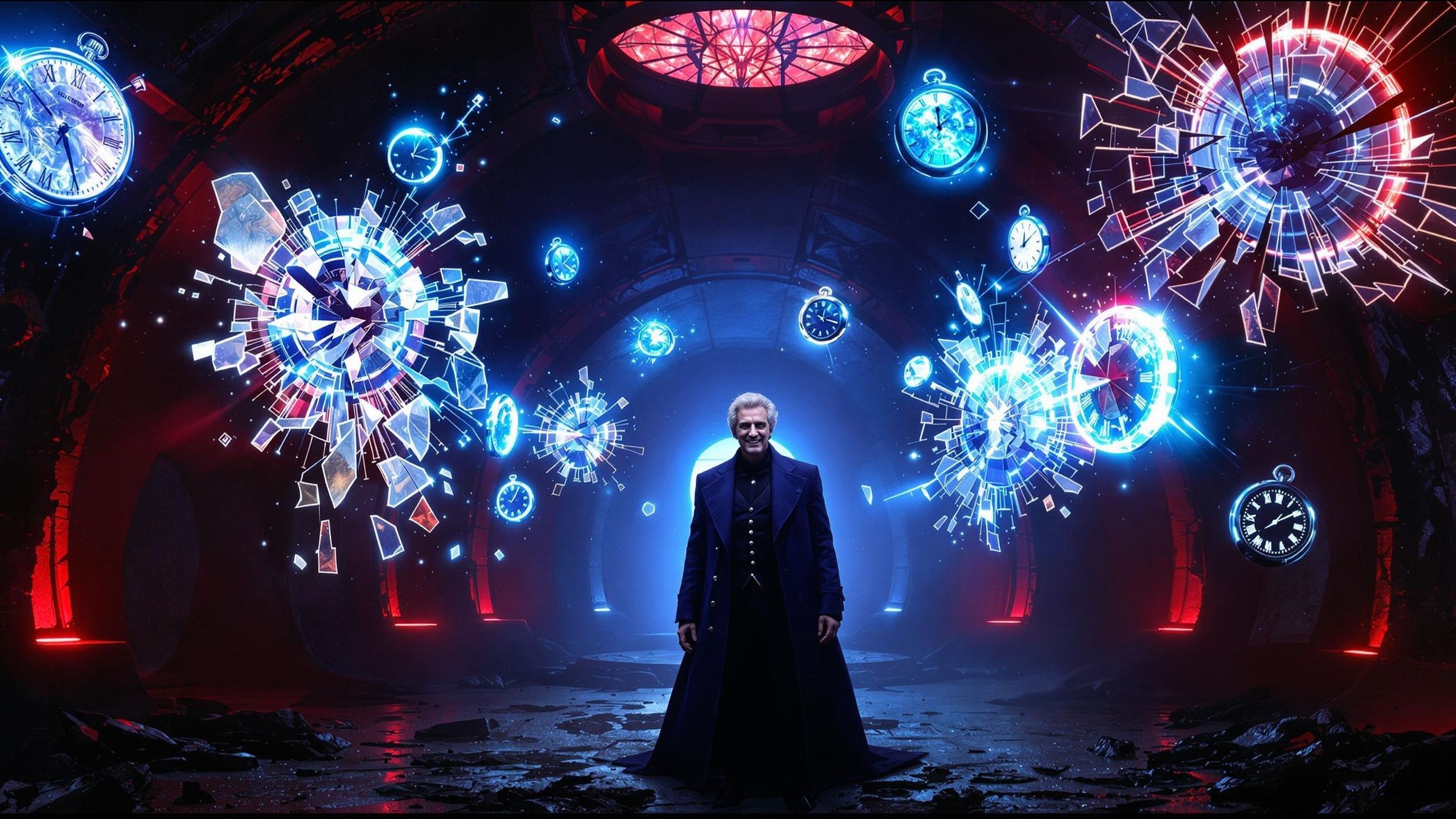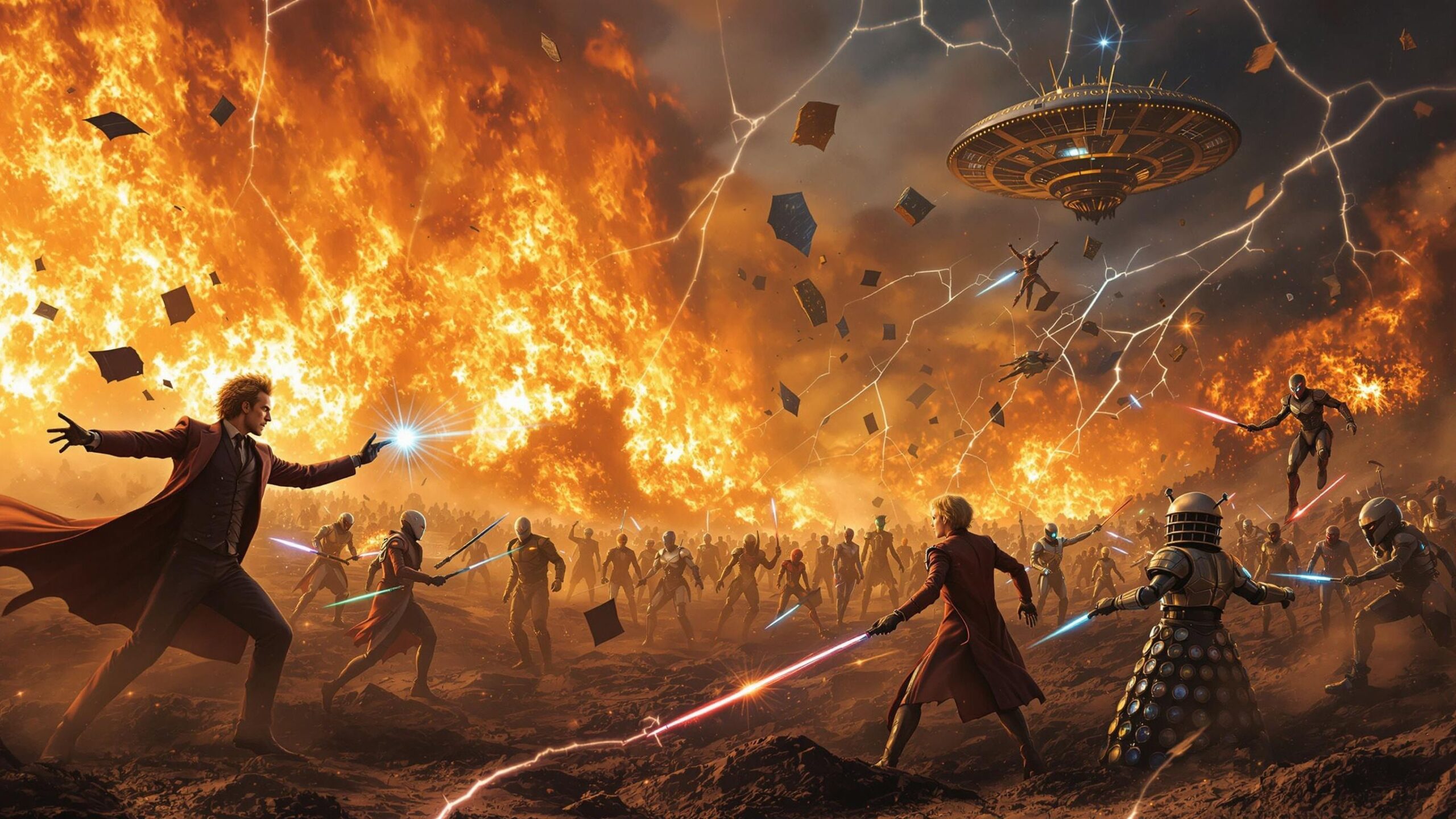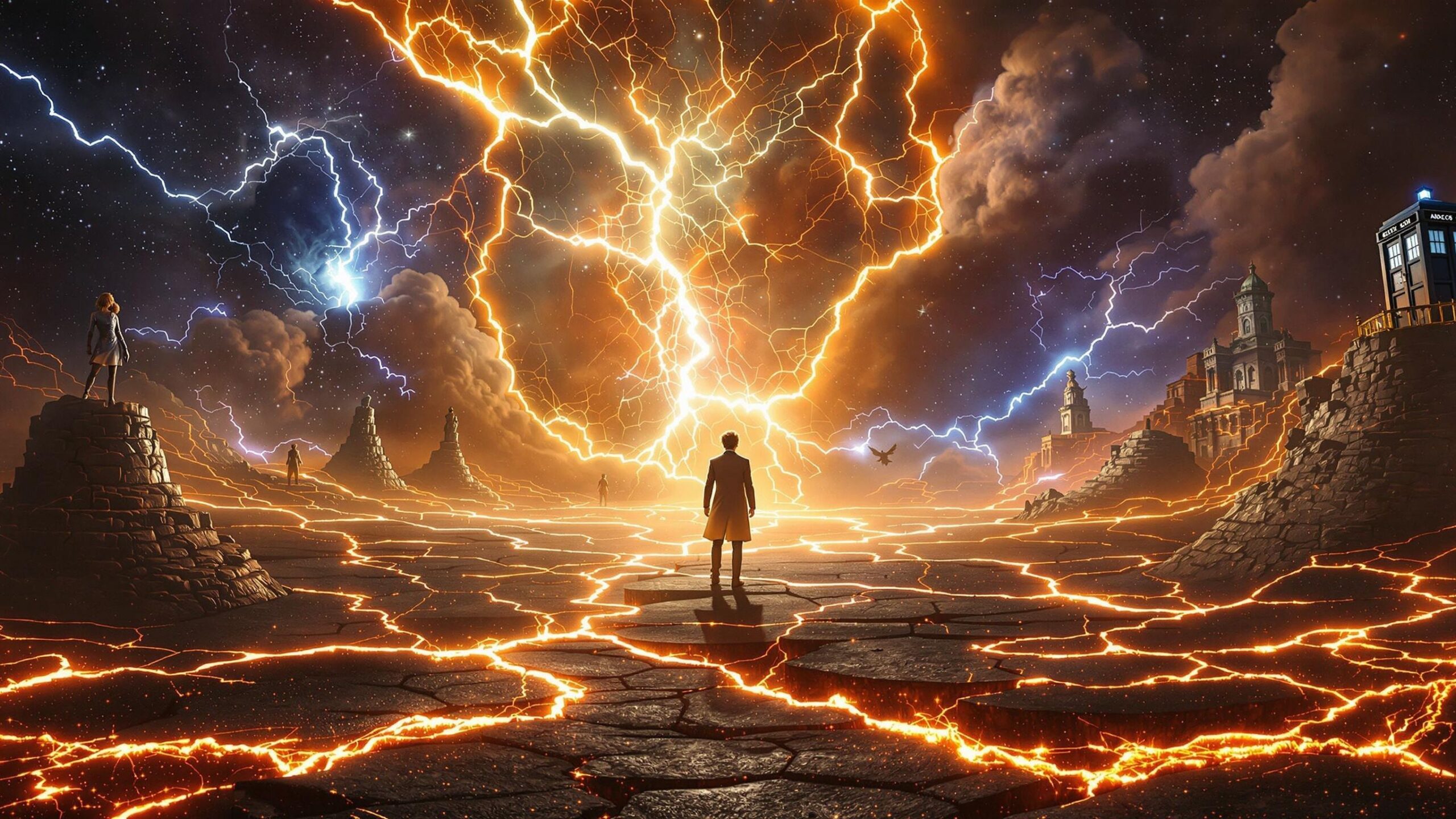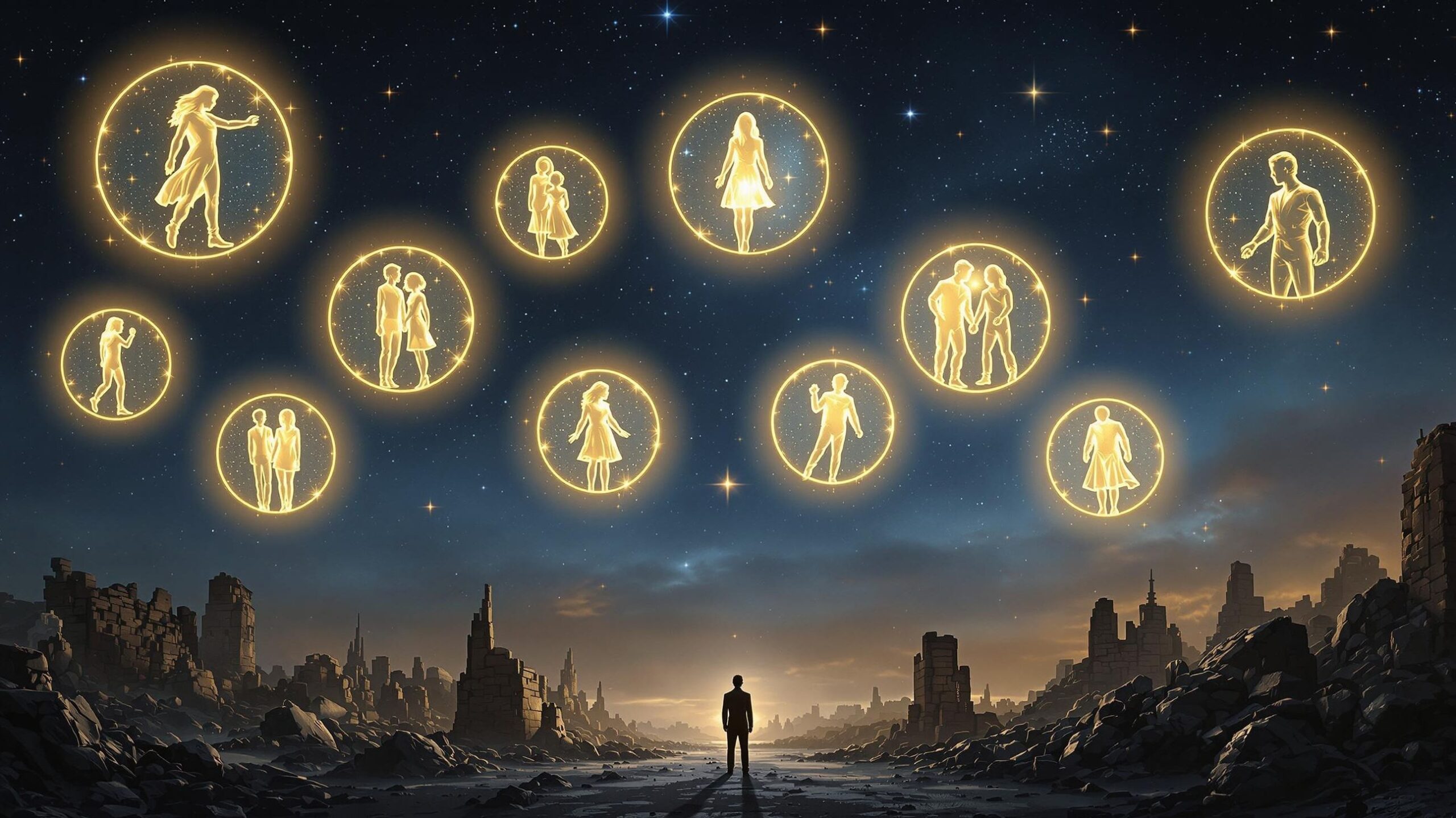The Master is the Doctor’s greatest nemesis—not just because they’re a fellow Time Lord, but because their brilliance is twisted by cruelty, chaos, and a deep, personal obsession with the Doctor. Where the Doctor heals, the Master corrupts. Where the Doctor inspires, the Master dominates. But what truly sets the Master apart from other villains is the scale and ingenuity of their schemes. Their plans aren’t just evil—they’re sinister: darkly personal, philosophically warped, and often as brilliant as they are horrifying. From mass hypnosis to rewriting time itself, the Master’s plots have shaken the foundations of the universe. These ten moments showcase when the Master wasn’t just bad—they were at their most dangerously diabolical.
#10: Turning the Earth into a factory for war (The Sound of Drums/Last of the Time Lords, 2007)
As Harold Saxon, the Master uses political manipulation, media control, and public trust to rise to the office of Prime Minister of Britain. But instead of governance, his true aim is domination. He unleashes the Toclafane—humanity’s own warped future selves—to decimate the population, enslaving the Earth and turning it into a war machine. Over the span of a single year (hidden in a time lock), the Master imprisons the Doctor in a cage, humiliates him daily, and ages him into a withered husk. What makes this plan particularly sinister isn’t just the destruction—it’s the psychological cruelty. The Master relishes his power over the Doctor, breaking his spirit in front of Martha and Jack. Its tyranny laced with mockery, wrapped in cosmic irony. The Earth becomes a stage, and the Doctor is the caged performer. All for the Master’s pleasure.
#9: Shrinking people into pocket corpses (Terror of the Autons, 1971)
The Master’s use of the Tissue Compression Eliminator (TCE)—a weapon that shrinks people to the size of dolls while killing them—is one of the most bizarrely grotesque tools in Doctor Who history. In Terror of the Autons, he uses it without hesitation, leaving behind tiny, contorted remains that haunt viewers with their unnatural appearance. It’s not just murder—it’s theatrical. The visual horror of the TCE reflects the Master’s penchant for terror as performance. He doesn’t just want to eliminate obstacles—he wants to do it in a way that unsettles everyone who sees the result. The weapon embodies his warped sense of superiority and his desire to make people feel small—literally and figuratively.
#8: Awakening the Nestene Consciousness (Terror of the Autons, 1971)
In his debut story, the Master aligns himself with the Nestene Consciousness and helps it invade Earth using the Autons—mannequins that come to life and kill. But it’s the infiltration that makes this plan so eerie. Plastic daffodils that suffocate, chairs that consume people, dolls that strangle—he weaponizes everyday items into murder tools. This plan preys on the mundane, turning common household goods into instruments of terror. It’s not about brute force—it’s about psychological horror. The Master understands that the most terrifying invasions aren’t always visible; they’re the ones that make you afraid of your own home. His alliance with the Nestenes showed early on just how creative—and creepy—his villainy could be.
#7: Destroying the universe with paradoxes (The Sound of Drums, 2007)
By manipulating the paradox machine—crafted from the Doctor’s own TARDIS—the Master allows the Toclafane to exist in the same timeline as their ancestors, breaking the laws of time itself. This plan is deeply nihilistic: the Master doesn’t just want to rule—he wants to unravel reality. The paradox is a direct affront to the Time Lords’ sacred laws and the Doctor’s entire philosophy. By weaponizing time in this way, the Master shows that their evil isn’t just personal—it’s cosmic. It’s not enough to kill or conquer. They want the universe to suffer under contradictions so profound they tear reality apart.
#6: Converting the dead into Cybermen (Death in Heaven, 2014)
Missy—one of the master’s most deliciously unhinged incarnations—devises a plan to turn the dead into Cybermen, raining their minds down as dark water and uploading them into new, metallic bodies. It’s a blend of necromancy and technology that’s deeply disturbing. What makes this plan so sinister is Missy’s motivation. She doesn’t do it to rule or to win. She does it to give the Doctor an army. Her goal is to prove that he and she aren’t so different. The entire nightmare is designed to corrupt the Doctor’s ideals, to force him to see himself through her warped mirror. That’s villainy at its most personal and psychological evil as a love letter.
#5: Turning humanity into the Master (The End of Time, 2009)
In one of the most twisted and surreal plots ever devised in Doctor Who, the Master creates a machine that literally overwrites the DNA of every human on Earth—turning all of them into himself. The result? A planet full of Masters, each cackling with his manic energy and distorted personality. It’s not just a power grab—it’s a horrifying identity apocalypse. The sheer scale of the madness is unmatched: friends, family, entire governments all become the same man. What makes it so terrifying is that it strips away individuality, choice, and humanity itself—replacing it with pure ego. The Master doesn’t just want control. He wants sameness, imposed in the image of his own madness. And for a brief time, he wins. It’s an invasion not of bodies, but of identity, and it stands as one of the most conceptually disturbing schemes ever put to screen.
#4: Killing the Time Lords again (Spyfall / The Timeless Children, 2020)
In one of the most shocking twists of the modern era, the Master returns in Spyfall with a secret he can’t contain: he has discovered the truth about the Timeless Child, a secret so devastating that it leads him to burn Gallifrey to ashes again. But this time, it’s not out of revenge—it’s out of existential rage. Upon learning that the Doctor is the origin of all Time Lord regeneration, the Master’s identity shatters. In The Timeless Children, he takes it even further: harvesting the corpses of his fellow Time Lords to create Cybermen with regeneration abilities. These “CyberMasters” are immortal soldiers—deadly, cold, and Time Lord-empowered. The fusion of the show’s two greatest enemies—Cybermen and the Master—was a devastating escalation. He didn’t just kill his own people. He twisted them. It’s a masterstroke of spite, horror, and deep personal betrayal.
#3: Missy’s “gift” to the Doctor (Death in Heaven, 2014)
Missy’s true plan isn’t to destroy Earth or enslave humanity—it’s to give the Doctor a Cyberman army. Her logic? If the Doctor has power, he’ll have to admit they’re the same. This isn’t about domination—it’s about breaking the Doctor emotionally, forcing him into a position where morality becomes murky. The sheer elegance of the plan is terrifying: she doesn’t need to win through violence—she wins by proving a philosophical point. By giving the Doctor ultimate power, Missy tries to force him to become what he hates most. It’s not a battle—it’s a seduction. And that’s what makes it so terrifying: it’s evil masked as a gift, villainy hidden in love. It’s the kind of plan only someone who knows the Doctor could devise—and that’s why it hits so hard.
#2: Creating the CyberMasters to reshape the universe (The Timeless Children, 2020)
Building off his earlier plan, the Master doesn’t just kill the Time Lords—he transforms their corpses into an army of CyberMasters, unkillable cybernetic Time Lords who can regenerate indefinitely. It’s a nightmare scenario: a fusion of organic and mechanical life, powered by death and betrayal. But what makes this plan so diabolical isn’t just the horror—it’s the purpose. The Master intends to spread this new race across the universe, reshaping everything in his own dark image. This is eugenics, necromancy, and cosmic fascism all rolled into one. It’s not just conquest—it’s a violation of life and death, choice and legacy. And it all stems from one singular source of pain: the Master’s jealousy and rage that he wasn’t the Timeless Child. The personal becomes universal. The wound becomes a weapon. And the universe is nearly rewritten as a result.
#1: Destroying the Doctor’s sense of identity (The Timeless Children, 2020)
Sometimes the most sinister plan isn’t about death or destruction—it’s about truth. When the Master reveals to the Doctor that her origins lie not on Gallifrey, but in a forgotten life that predates Time Lord society, it shatters everything she believed about herself. The revelation that she is the Timeless Child—that the Time Lords harvested her regeneration for their society and then wiped her memory—reframes everything. And the Master revels in it. This isn’t just information—it’s a calculated psychological strike. The Doctor’s entire identity, her moral code, her understanding of her own life is upended. It’s villainy at its most surgical: stripping away a hero’s sense of self. And the Master doesn’t have to raise a finger—he just tells the truth. This makes it his most sinister plan of all: not because of how many die, but because of how many doubts are born.
The Master isn’t just evil—they’re intimate evil. Their greatest plans are never just about taking over planets or killing enemies—they’re about dismantling hope, identity, and meaning. The Master’s genius lies in how personal their villainy always is. From destroying Gallifrey to breaking the Doctor’s heart, each plot is crafted with the precision of someone who knows where it hurts the most. And that’s what makes their plans not just dangerous—but sinister.




